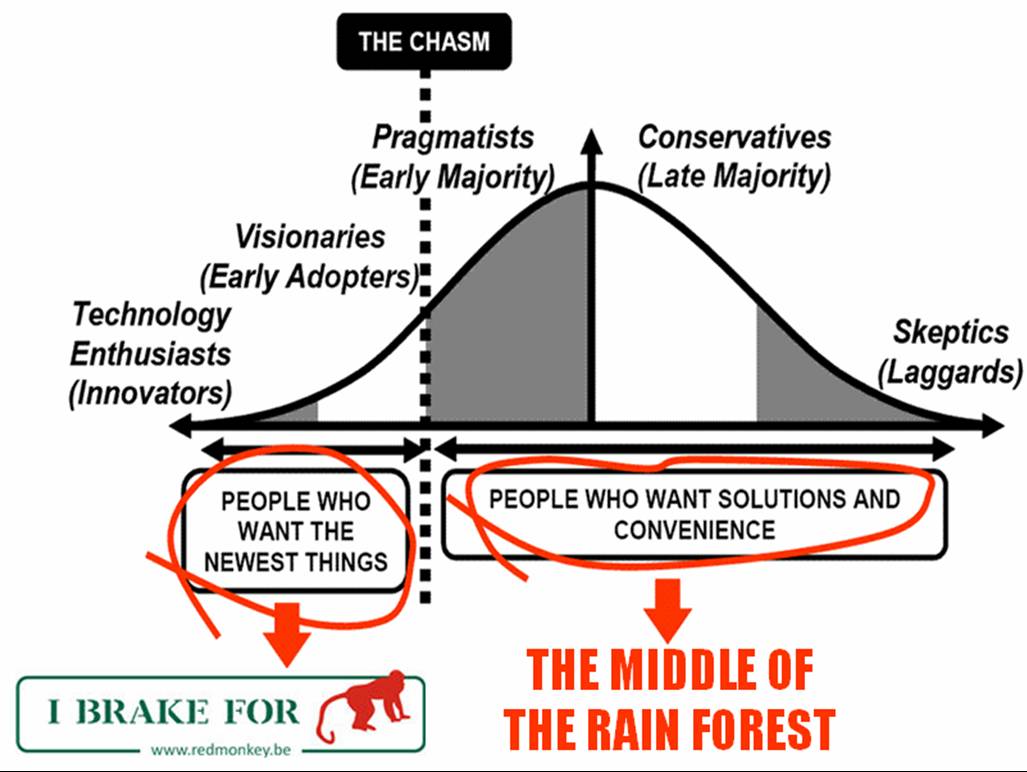Unexpected – like innovation itself – another perspective that I’d like to add to this series: the newest insights on biodiversity. Some time ago, Jef Staes introduced the concept of a red monkey. According to Jef, the concept started to develop during his seminars when participants asked him where to start with very confrontational change projects.
At that moment, he just learned about the origin of the rich biodiversity in a rain forest. According to the latest insights in biodiversity, new species do not start in the middle of a forest but at the edge. At the edge! – where different species from different ecosystems ‘meet’. That’s when Jef created a metaphor of a brown monkey from the jungle who meets a red fish from the sea (an adjacent ecosystem). Through their conversation a new confrontational idea is born: a red monkey.
What would happen if that confrontational idea would be dropped in the middle of the jungle? It would be killed immediately. Jef notes that the same happens with confrontational ideas that are ‘dropped’ in the middle of an organization … they get killed as well. Innovation ‘never’ starts in the middle of an organization but on the edge, where ecosystems meet. In the below video you can see Jef explaining the concept.
In the long run, red monkeys are key if organizations are to survive. A red monkey disturbs the balance in people, teams and organisations – it tilts the stability of an ecosystem, and therefore it will get killed if there is no ‘critical mass big enough to survive.
Innovation is the result of a red monkey that has managed to survive the initial conflict between these two opposing points of view. And that is why we need all that stuff about organizational change management: to get from the edge to the middle! No need to mention that Jef is passionate about the subject; he even designed a bumper sticker:
For those of you who wonder how this red monkey metaphor relates to the previous articles in this small “conflict” series have a look at where I pasted the bumper sticker.

You will immediately note that it will take a serious amount of conflict before you can introduce the red monkey on the right hand side of that chasm. As I have written earlier: this is a step-by-step process and it requires a different view on resistance. Thanks to Jef it is now crystal clear that you should start at the edge and move to the middle – gradually as you implement all the stuff I’ve been blogging about over the past 2 years.
Bonus material for Dutch-speaking readers: Jef Staes talking about the next generation of young employees on a symposium about leadership in education organizations. You will note that Jef’s ideas have a lot in common with John Seely Brown when talking about the social life of information (aka: knowledge Management) and the gap / conflict / clash (whatever you want to name it) between generations.
Click here for part 1 of “Jongeren zijn anders”
Click here for part 2 of “Jongeren zijn anders”







Pingback: Luc’s Thoughts on Organizational Change » Blog Archive » A conflict isn’t always a bad thing - Part 6()
Pingback: Luc’s Thoughts on Organizational Change » Blog Archive » Belgian Media Grinding to a Halt? Big Time.()
Pingback: Luc’s Thoughts on Organizational Change » Unleash the Red Monkey (A Twitter Tale)()